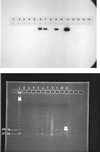A strategy for detection of viruses in groundwater by PCR
- PMID: 9925566
- PMCID: PMC91045
- DOI: 10.1128/AEM.65.2.444-449.1999
A strategy for detection of viruses in groundwater by PCR
Abstract
We evaluated the use of the PCR for detection of enteric viruses in groundwater. To do this, we used an improved sample-processing technique and a large-volume amplification protocol. The objective of this study was to use advanced molecular techniques to develop a rapid and simple method which can be used by the water industry for detection of viral contamination in a variety of water samples. The strategy described here fulfills the water industry's need for a rapid, reliable, easily performed method for analyzing groundwater for virus contamination. Viruses were detected after concentration from at least 400 gallons (1,512 liters) of water by a filter adsorption and elution method, which resulted in a concentrate containing viruses. A total of 150 samples were analyzed by performing cell culture assays for enteroviruses and by performing reverse transcription PCR (RT-PCR) analyses for enteroviruses, hepatitis A virus, and rotavirus. Thirteen samples (8.7%) produced cellular cytopathic effects when the Buffalo green monkey cell line was used. When primers specific for enteroviruses were used in RT-PCR, 40 of 133 samples (30.1%) tested positive for the presence of enterovirus RNA. When hepatitis A virus-specific primers were used, 12 of 139 samples (8.6%) were considered positive for the presence of hepatitis A viral RNA. The RT-PCR analysis performed with rotavirus-specific primers identified 18 of 130 samples (13.8%) that were positive for rotavirus RNA sequences. Our sample-processing technique and large-volume PCR protocol (reaction volume, 300 microliter) resulted in sufficient removal or dilution of inhibitors so that more than 95% of the samples could be assayed by PCR. Because of its sensitivity for detecting viral nucleic acid sequences, PCR analysis should produce more positive results than cell culture analysis. Since either cell culture analysis or PCR can reveal only a "snapshot" of the quality of the groundwater being sampled, PCR seems to be a desirable rapid initial screening tool.
Figures





References
-
- Craun G F. Health aspects of groundwater pollution. In: Bitton G, Gerba C P, editors. Groundwater pollution microbiology. New York, N.Y: John Wiley & Sons, Inc.; 1984. pp. 135–179.
-
- DeLeon R, Shieh C, Baric R S, Sobsey M D. Proceedings of the 1990 American Water Works Association WQTC. 1990. Detection of enteroviruses and hepatitis A virus in environmental samples by gene probes and polymerase chain reaction. Advances in water analysis and treatment; pp. 833–853.
-
- Edzwald J K, Van Benschoten J E. Proceedings of the 4th Gothenburg Symposium on Chemical Water and Wastewater Treatment. 1990. Aluminum coagulation of natural organic matter; pp. 341–359.
-
- Hyypia T, Auvinen P, Maaronen M. Polymerase chain reaction for the human picornaviruses. J Gen Virol. 1989;70:3261–3268. - PubMed
Publication types
MeSH terms
Substances
LinkOut - more resources
Full Text Sources
Other Literature Sources

